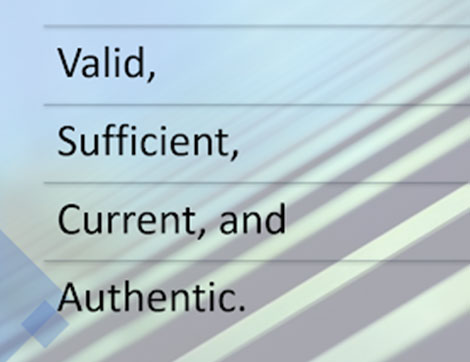An easy way to learn them:
“I need something valid
like a current driver’s license
sufficient money for rent and
an authentic friend”
In the Rules of Evidence, important considerations around assessment evidence collection are highlighted in relation to the Principles of Assessment.
Validity
The assessor must be assured that the student has the skills, knowledge, and attributes as described in the unit of competency and associated assessment requirement.
In order for the validity rule to apply, the assessor must have confidence that the learner has the skills, knowledge, and attributes required within the module or unit of competency and assessment. This basically means that the assessment process assesses the competence of the learner, as it claims.
What do RTOs do to ensure the validity of their assessments?
For competent performance, assessments cover a wide range of skills and knowledge:
The assessment of knowledge and skills is integrated with the application of those skills
Upon completion of the assessment, the learner is able to demonstrate their skills and knowledge as needed
A competency can be determined by aligning the learner’s performance with a unit or units of competency and the requirements for assessment
You must ensure that your RTO Assessment tool meets the requirements of each unit and that it can confirm the repeatability of performance as well. Assessments must not omit anything from the unit, nor should they expect anything beyond what the unit requires
Sufficiency
The assessment must be assured that the quality, quantity, and relevance of the assessment evidence enable a judgement to be made of a student’s competency.
Under the Sufficiency rule, assessors must be confident in the quality, quantity and relevance of the assessment evidence before making a judgement.
This means that units or modules may specify a minimum number of times a task must be completed before learning is considered sufficient.
For example, an engineer may need to complete four welding tasks to demonstrate sufficiency, while a hairdresser may need to complete eight haircuts. The standards for determining sufficiency are usually established by RTOs in line with industry requirements.
There are various ways that assessors can gather evidence to satisfy the Sufficiency rule. This may include observing learners in action at their workplace, viewing videos of role plays at simulated workplaces, and using a checklist to ensure all required skills are being demonstrated.
Satisfying the Sufficiency rule is essential for making accurate and reliable judgements about a learner’s achievement. This, in turn, ensures that learners receive the appropriate training and assessment to meet industry standards.
Quality, Quantity and Relevance
Quality refers to the extent to which a program meets the needs of its participants. It is important to ensure that training and assessment programs are of high quality so that participants can gain the skills and knowledge they need to be successful in their chosen field.
Quantity refers to the amount of training and assessment that is required in order for participants to gain the desired skills and knowledge. It is important to ensure that there is enough training and assessment so that participants can gain a thorough understanding of the material covered.
Relevance refers to the extent to which a program is applicable to the real world. It is important to ensure that training and assessment programs are relevant so that participants can apply what they have learned in a practical setting.
Training and assessment programs that focus on quality, quantity and relevance will be more effective than those that do not. Therefore, it is important to ensure that these three factors are taken into account when designing training and assessment programs in the VET sector.
Authenticity
The assessor must be assured that the evidence presented for assessment is the student’s own work.
The evidence presented in vocational education and training (VET) assessments must be authentic in order for the rule of evidence to be applied correctly.
This can be challenging to ensure in a distance learning environment, but there are a few strategies that can help.
These include asking students to agree not to share logins and passwords, requesting IDs online prior to assessment, signing declarations that all evidence submitted is their own work, or using live-webcam proctoring during assessments.
By following these steps, assessors can be confident that the evidence presented is indeed from the learner and meets the Authenticity rule.
The evidence presented in vocational education and training (VET) assessments must be authentic in order for the rule of evidence to be applied correctly.
This can be challenging to ensure in a distance learning environment, but there are a few strategies that can help.
These include:
- checking for plagiarism
- asking students to agree not to share logins and passwords,
- requesting IDs online prior to assessment,
- signing declarations that all evidence submitted is their own work, or
- using live-webcam proctoring during assessments.
By following these steps, assessors can be confident that the evidence presented is indeed from the learner and meets the Authenticity rule.
Currency
Currency refers to how up-to-date the evidence used in an assessment is. The reason this is so important is as vocational training is always changing and evolving. What was once considered best practice may no longer be relevant a few years down the line. This means that any assessments carried out need to use evidence that is current and relevant.
An assessor must be confident that the evidence presented in an assessment demonstrates current competency in order to apply the Currency rule. Students must present evidence from the recent past or the present.
How recent is the “very recent past”? Each industry will have its own definition of what is considered current, and in some cases, individual units will provide guidance. Most evidence gathered more than two years ago cannot be considered current; however, in some cases, it may be accepted. In determining what evidence is considered current, RTOs should refer to industry standards.











